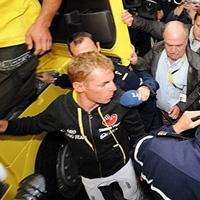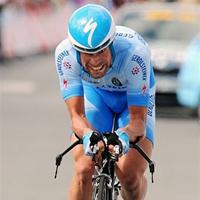
Recently on Cyclingnews.com |
News Feature, December 1, 2008
CERA's shadow casts doubt
This year's Tour de France was almost certainly not the first time CERA has been used. Cyclingnews' Shane Stokes finds out that this latest generation of EPO may have been influencing results in major events for at least a year before le Tour 2008.

|
The first widespread knowledge of the use of the Continuous Erythropoietin Receptor Activator (CERA) drug Mircera in sport occurred when the Italian Saunier Duval-Scott rider Riccardo Riccò was ejected from the Tour prior to the start of stage 12. It followed earlier positives for ‘standard' EPO by Manuel Beltran (Liquigas) and Barloworld rider Moisés Dueñas.
Contrary to suggestions made at the Tour, the third generation EPO agent - Mircera - was commercially available for almost a year prior to its first detection as a doping agent. It means that CERA could have been used in the 2007 Vuelta a España and world championships, in addition to other major events.
At the time of Riccò's explusion from the race, many statements were made by WADA, the UCI and other parties - that testers were ahead of the game and had already determined a method to detect CERA before its widespread use in the peloton. WADA spokesman Frédéric Donzé said immediately after Riccò's positive test that the news was, "a further indication that the net is closing on those athletes who still take the risk to dope. Thanks to the co-operation of the manufacturer of this substance (Roche) and of WADA-accredited laboratories, WADA received the molecule well in advance and was able to develop ways to detect it."
Positive tests for CERA from Riccò, Giro King of the Mountains Emanuele Sella [analysed outside the Tour], plus later blood analyses implicating Stefan Schumacher, Leonardo Piepoli and Bernhard Kohl were all touted as successes, and proof that the net was closing in. The UCI was similarly celebratory about the detections, and echoed WADA in saying that they showed that the testers were ahead of the cheats.
CERA could have been in use for a much longer period of time, however. It was approved for EU use at the end of July 2007 and at the time company statements indicated that it would be immediately released in Germany and the UK. This month, Cyclingnews sought clarification that this was the case. "Mircera was approved in the European Union in July 2007 and to date it has been launched (become commercially available) in 19 European countries and another 19 countries around the world," said a Roche spokeswoman.
"It's possible that it was in use last year and maybe even the year before."-Anonymous team representative claims that CERA may have been well-established in the peloton. |
This is far earlier than was acknowledged by WADA and the UCI at this year's Tour; indicating that CERA may have been used by riders taking part in last season's Vuelta a España and World Championships. It also correlates with statements made this week by Kohl, who said that he first heard about CERA last year.
To date, CERA testing has not been applied to any samples taken earlier than the summer of 2008.
In October, Giro d'Italia chief Angelo Zomegnan insisted that there would be no retroactive testing of samples from this year's race, despite the fact that two of the Giro's biggest stars - Riccò and Sella - excelled. Given that both were later proven to have used the substance, many have questioned Zomegnan's decision.
Additionally, Stefan Schumacher displayed unusual blood values during the 2007 world championships, where he placed third. The German rider explained the readings as an after-effect of an intestinal infection suffered in the days leading up to the road race and, at the time, the German national federation implied that his values were within the UCI's limits. "A removal from competition at no time came into consideration [sic]," it said.
Schumacher later admitted that he was over the 50% hematocrit cutoff point, clocking in at 50.5%, but was below the haemoglobin threshold of 17 g/dl and thus avoided suspension. He insisted his high readings were due to the diarrhoea caused by his illness, something the UCI investigated and then accepted.
However his positive tests for CERA in the 2008 Tour now lead to questions about that explanation. Is he innocent of any drug use, as he still maintains, or was he already using the substance last autumn? Without retesting, it's impossible to know.
Tour 2007

|
Given what has happened this year, could last season's Tour come under a CERA cloud? Roche's release date statement would tend to suggest that it wouldn't - the only way for riders to acquire Mircera prior to this date would be on the black market or via clinical trials.
One team representative (who wished to remain anonymous) told Cyclingnews that he thought there were grounds for concern. "Based on this [the release date], it could have been in the Tour 2007, for sure," he said. "I think some of these 'sport' doctors look for new drugs like this."
A Spanish media report by ABC.es the day after Operación Puerto broke listed "CERA - a hormone similar to EPO" as one of the substances seized from Eufemiano Fuentes in May 2006.
Cyclingnews has sought to confirm the accuracy of that report with ABC journalists but has not yet received a reply.
Clinical trials for Mircera were undertaken in 2006, while phase I/II trials took place in 2003 and July 2004. At the time French daily Le Monde warned it could already be in the peloton. "It's possible that it was in use last year and maybe even the year before," speculated the same team representative. "I think these trials are very limited to start, and then expand. That expansion probably extends the potential for abuse."
Contacted for a reaction to possible black market dealings of its product, Roche played down suggestions that Mircera could have been found during the Operación Puerto investigations. "While we cannot speculate on the raid in Spain, we do not believe that any athletes had access to Mircera prior to it being approved in 2007," said the spokeswoman. "All use prior to that was in clinical trials for patients with anaemia due to chronic kidney disease, for registration of the drug.
"Roche has strict regulations and monitoring of all its products... from the initial production of the active pharmaceutical ingredients through to the finished product formulations and delivery to business customers. The company has had no reports of missing supplies of its drug. It is ultimately the role of the physicians and pharmacists to ensure that medicines are dispensed and used responsibly to the benefit of patients in accordance with their approved indications."
The final line indicates that physicians are an important link in ensuring that the substance is only used by those with a medical necessity. Unfortunately, as individuals such as Dr. Eufemiano Fuentes and Dr. Carlos Santuccione have shown, this can often be the weak link in the chain.
The UCI responds
Why CERA?One of the benefits of CERA is that unlike other forms of EPO, it gives a slower and more sustained reaction. It leads to remarkably stable haemoglobin concentrations in the blood, avoiding some of the troughs and peaks which can make doping manipulation evident to those who are scrutinising athletes. In a report issued on the Roche website on November 10, it was stated that, "interim study results from 90 renal centres in Germany confirm for the first time that in a real-life setting Mircera® maintains haemoglobin (Hb) levels within a narrow range," for chronic kidney disease (CKD) patients. Specifically, the report states that during the study evaluation phase, 84 per cent of the patients monitored showed haemoglobin levels that deviated by less than or equal to 1 g/dL from the individual mean. In a sporting context, the use of a product such as CERA would enable the rider to avoid the flucuations in hematocrit and haemoglobin which are one of the red flags indicating possible EPO use. Those injecting the substance would hope to stay under the radar, maintaining steady blood levels and thus duping the anti-doping officials. |
In relation to Roche's claims, UCI President Pat McQuaid said, "Our awareness and statements were based on information we received from WADA and the media. We were not in contact with the manufacturer and until the AFLD found Riccò positive, we had no knowledge that it was being used in the peloton.
"We saw no reference to CERA in the Fuentes documents, nor did we hear anything from anyone else referencing it."
Garmin Chipotle H3O manager Jonathan Vaughters also said that he was unaware it may have been in use for some time. Vaughters' team is regarded as having one of the strongest anti-doping stances in cycling. "I didn't know about CERA until the scandals started breaking," he told Cyclingnews on Thursday. "I doubt it is widely used, nor ever has been."
Despite the July 2007 launch date, he took the view that its use was only recent. "I think it's a great example of WADA, UCI and AFLD getting out in front of the problem, before it becomes much of a problem at all. Imagine if an EPO test had been developed in 1990? That's what this is the equivalent of."
Unfortunately, it's unclear as to what can be done in relation to past races. McQuaid explained that the governing body was not opposed to rechecking where possible. "If we feel there is a value in re-testing samples on any event because of a development of a new test we will do so," he said. "However urine samples are required by WADA to be kept for [only] three months. We have asked for samples from the Giro and the 2008 worlds." McQuaid added that after the three-month period, samples kept in WADA labs may be destroyed.
Biological passport vital tool
CERA is another example of the ever-changing nature of doping in sports. Pronouncements by WADA and others that tests were devised almost immediately after it was introduced to the peloton are naïve at best; when looking for specific products, authorities are almost always going to be playing catch-up to those who are trying to beat the system. However, Team Columbia's Bob Stapleton believes that once the UCI's biological passport is fully up and running, the system of longitudinal testing will make it much tougher to cheat.
"Retesting is fine with me, although I am not really passionate about it," he said. "I like the [notion of] increased suspension terms a lot. It's crazy that these guys are almost back racing. However, the real emphasis needs to be placed onto sanctions coming from the passport.
"The beauty of the passport is that you act on changes or odd values, without having to prove it was CERA, Mexican EPO, or any other specific drug, new or old. That is the real break-through. You don't have to test to identify the substance, just document that something is sufficiently abnormal and then act. It stops the 'doping arms race' of new tests chasing new drugs."
Vaughters also chooses to look forward rather than back. "On our team, we haven't really discussed CERA," he stated. "I don't think anyone had heard of it, and quite frankly, we don't really care. Doping just isn't a topic inside of our team, as we don't have any control over what the rest of the world does. We just go about our business, and do the best we can. Hopefully, that will continue to be enough to win some more races.
"Our new testing system is focusing intently on the generation of EPO biosimilars, of which CERA is a part. So, we'll eliminate the possibility of having anyone we stick on the start line having experimented with this crap. I don't think they would anyway, as I trust my boys, but the testing will double-check this."
As they suggest, longitudinal testing and the ability to sanction or suspend without a positive test for a specific substance is a valuable weapon in the future fight against drug use. Yet, even if it will no longer be so crucial to pinpoint the exact doping agent, the CERA example shows that imperfections exist in the current system.
Firstly, regulations to keep urine samples for three months only - as McQuaid stated is the WADA rule - is extremely limiting. If the dopers need only be a mere 90 days ahead of the testers, then it's simply impossible to verify past results and to know that Grand Tour winners or world championship medallists are genuine. If any samples remain from 2007, they should be restested and any CERA users banned.
Secondly, back-patting statements by WADA, the UCI and others that the testers are ahead of the cheats need to be backed up by fact. Claiming that the authorities were on top of the CERA problem and nipped it in the bud simply doesn't correlate with the facts of a launch date almost a full year earlier. Instead, it makes such statements look naïve or, worse, a wilful attempt at PR damage control. And that does nothing to restore confidence in the long run.
